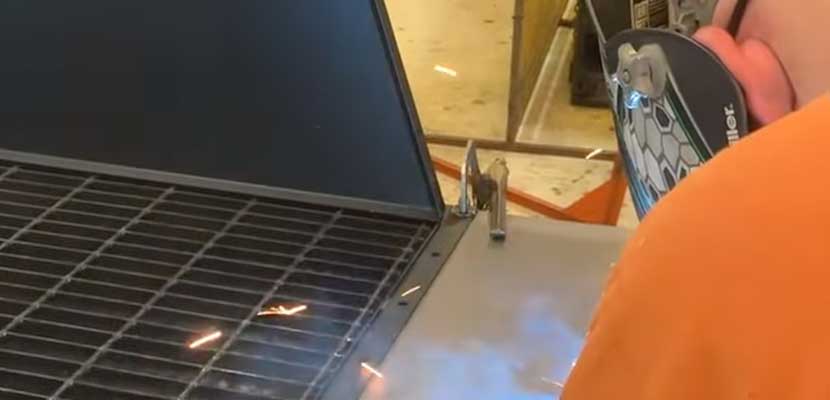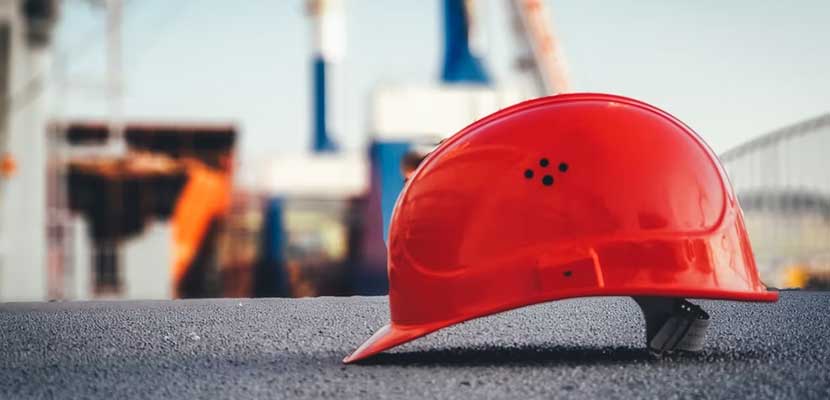What is a Downdraft Table? How Does it Work?
Clean Air Industries
on
February 2, 2024

Do you work in the manufacturing industry? Is your idea of great customer service a minimized mess after you’re done welding or grinding? If yes, perhaps a downdraft table is what you need.
Downdraft tables, a powerful, steel-made, motor-run asset, makes working with small tools and compact machinery considerably more efficient. To protect the motors, many downdraft tables have pierced table tops with filters that collect all the dust.
In essence, a downdraft table enables you to keep your workspace clean when undertaking tool work through filters. And this is precisely the reason why they are so very popular among woodworkers. A downdraft table is largely used to collect dust particles and tiny debris that occur in manufacturing processes such as welding or grinding.
Application of downdraft tables
Downdraft tables are most commonly found in metalworking and woodworking businesses. But, you will notice that most of these units have further applications in your company. Serving as a work surface, these tables can be utilized in any place where the fumes need to be kept away from employees. You can gather your materials and all the machines or tools, and simply proceed to the table to start working on it. These tables offer a significant advantage over a standard workbench in that way.
Downdraft is a name that is derived from the downdraft airflow that the table produces when turned on. It is this airflow that helps keep all of the debris from entering your body via your nose, lungs, or even eyes. It keeps the wooden shavings and sawdust hidden away from your workspace, giving you a neat and clean working environment along with clarity pertaining to your task at hand.
Types of downdraft tables
There are different downdraft tables available for different purposes. Each has its own set of advantages and downsides. The design of these tables is also slightly altered to meet particular requirements.
Let us discuss the two commonly used downdraft tables – one for woodworking and the other for metalworking. You must thoroughly understand each type before making a purchase to ensure that it matches your requirements.
Downdraft table for woodworking
Working with wood leads to the production of a lot of waste, like fine dust and microscopic particles. These pollutants can severely restrict your vision and make the entire experience of carrying out woodworking unpleasant and hazardous. Downdraft tables are common for woodworkers because of this reason precisely, since it helps in the proper elimination and disposal of the wood waste.
The perforated surface and dust collection system of the table allows you to remove dangerous wood dust particles, which can cause serious health problems if inhaled and thereby aid in the ensuring clean atmosphere for the manufacturers to work. Installing this table leads to reducing the risk of injury and contact with wood dust.
This is how a downdraft table can be used in workspaces that involve working with woods.
Downdraft table for metalworking

The application of a downdraft table is not just restricted to woodworking industries. A downdraft table has the potential to remove pollutants from dirty air because it is functioned to eliminate small particles. Contaminated air can be dangerous, so to be safe the system has to return clean air. This is what makes it popular among metalworkers as well. For most, it is considered a good small company investment rather than an expense.
Welding fumes (carcinogen), and they also pose a serious health hazard for the staff. These benches are well equipped for grinding because they neatly catch all of the shavings from the process, drastically reducing the chance of harm, thereby ensuring safety.
Furthermore, if the downdraft table has a solid particle filter, it removes them from the workers’ surroundings, giving the worker a clean environment. An additional benefit for the people working on downdraft benches is that it reduces the likelihood of injury caused by metal products.
General uses of downdraft tables
Most downdraft tables have features such as protection from spark shields, dust collection system, exhaust funnels, and heavy-duty work surfaces, among others, making them the perfect fit for manufacturing industries.
Downdraft tables are commonly used for chemical preparation for welding, woodworking, crushing, pulverizing, and hazardous material processing. Such operations are part of millions of people’s daily labor, and downdraft tables help accomplish that job efficiently. Hardworking personnel can complete their activities safely, thanks to the services provided by these tables.
What are the health and safety benefits of metal downdraft tables?
Downdraft tables serve two key purposes in the workplace: they safeguard the workers and meet industry-specific workplace requirements. Additional advantages include:
Fulfilling your legal obligations
Employers are required by law and regulation to create a safe and healthy work environment that is free of hazardous dust collection and smoke. An employer can meet these legal requirements and avoid penalties and sanctions from supervisory authorities by installing downdraft tables for its workers.
Elimination of fire and explosion hazards
Numerous types of industrial dust are combustible or flammable. Large amounts of plasma and oxy-acetylene dust, in particular, can cause fire. So, adding a downdraft table with features such as explosion-proof components, fire-retardant filters, and spark arrestors to mitigate the risk of ignition is the perfect solution as it is a preventative measure that can protect your workforce and avoid property damage if you conduct a lot of welding and cutting.
Do downdraft tables work?
This is largely dependent on the application. In many circumstances, downdraft benches are effective. It is dependent on two factors. Do you have a task that would benefit from the use of a downdraft table, and have you chosen an appropriate downdraft bench by going through all the useful information about the same? If your answer is yes for both, the tables should work for you.
Conclusion

Your workers will thrive in a dust-free atmosphere with a downdraft table in place, which implies fewer sick days and missed labor hours owing to air quality issues. Everyone will be able to breathe easier, and your company will save money in the short as well as long term if a proper downdraft table is put to use in your company.
Frequently Asked Questions
Q: Why Should I Invest in a Downdraft Table for My Workshop?
A: Investing in a downdraft table is a strategic decision that prioritizes the health and safety of your workforce while also safeguarding the quality of your work. By effectively removing harmful dust and fumes from the air, it not only creates a safer workplace but also reduces the risk of product contamination. This leads to higher quality outputs and fewer reworks. Additionally, it helps in complying with health and safety regulations, potentially reducing insurance premiums and legal liabilities.
Q: Can Downdraft Tables Be Customized to Fit Specific Needs?
A: Absolutely! Understanding that every workshop has unique needs, downdraft tables are highly customizable. Whether it’s the size of the table, the type of filtration system, or additional features like adjustable height and built-in lighting, there’s a wide range of options available to tailor your downdraft table to your specific operational requirements. This flexibility ensures that you can maximize both the efficiency and effectiveness of your workspace.
Q: How Do I Maintain My Downdraft Table and Ensure Its Longevity?
A: Maintaining your downdraft table is straightforward and essential for ensuring its longevity and optimal performance. Regular maintenance tasks include cleaning or replacing filters, inspecting the fan and motor for wear and tear, and keeping the work surface clean. Most models are designed for easy access to these components, making maintenance tasks hassle-free. Following the manufacturer’s maintenance schedule and guidelines will help keep your downdraft table running smoothly for years to come.
Q: Are Downdraft Tables Environmentally Friendly?
A: Downdraft tables are a testament to environmentally responsible manufacturing practices. By capturing and filtering out harmful particles and fumes, they not only improve the air quality within your facility but also contribute to a cleaner external environment. Many models feature energy-efficient designs and use reusable filters, further minimizing their environmental impact. Investing in a downdraft table is a step towards sustainable operations, demonstrating your commitment to environmental stewardship.
Q: How Does a Downdraft Table Contribute to Improved Work Efficiency?
A: A downdraft table significantly contributes to improved work efficiency by creating a cleaner and more organized workspace. The immediate extraction of dust and fumes at the source prevents the spread of contaminants across the work area, reducing cleanup time and minimizing equipment maintenance needs. This allows workers to focus on their tasks without interruptions, leading to faster project completion times and higher overall productivity. Additionally, the enhanced air quality reduces health-related absences, ensuring a consistently efficient workforce.
Q: What Types of Industries Benefit Most from Using Downdraft Tables?
A: Downdraft tables are incredibly versatile, benefiting a wide range of industries where air quality and cleanliness are paramount. Industries such as woodworking, metalworking, automotive refinishing, aerospace manufacturing, and electronics assembly find downdraft tables particularly beneficial. They are also invaluable in laboratories, educational settings, and art studios where fine particulate matter and fumes can pose health risks. Essentially, any industry that generates dust, fumes, or other airborne contaminants can significantly benefit from the use of downdraft tables.
Q: Can Downdraft Tables Help in Complying with Occupational Health and Safety Regulations?
A: Yes, downdraft tables play a crucial role in helping businesses comply with occupational health and safety regulations. By effectively removing hazardous substances from the air, they contribute to creating a safer workplace that meets or exceeds regulatory standards for air quality. This not only helps in avoiding potential fines and legal issues but also demonstrates a commitment to protecting the health and well-being of employees. Investing in downdraft tables is a proactive step towards ensuring compliance and fostering a culture of safety within the workplace.
Q: Are Downdraft Tables Safe for the Handling of Combustible Dust?
A: Downdraft tables are designed with safety as a paramount concern, including the safe handling of combustible dust. Models specifically engineered for environments where combustible dust is present are equipped with features such as explosion-proof components, fire-retardant filters, and spark arrestors to mitigate the risk of ignition. It’s crucial, however, to choose a downdraft table that is appropriately rated for the specific type of combustible dust you’re working with, as different materials require different safety measures. In some instances, a wet downdraft table, or a ducted downdraft table paired with a wet dust collector, may be required. Manufacturers often offer custom solutions to ensure compliance with National Fire Protection Association (NFPA) standards and local safety regulations. By selecting the right downdraft table and adhering to proper maintenance and operational practices, you can significantly enhance the safety of handling combustible dust in your workspace.
- Category: Uncategorized
